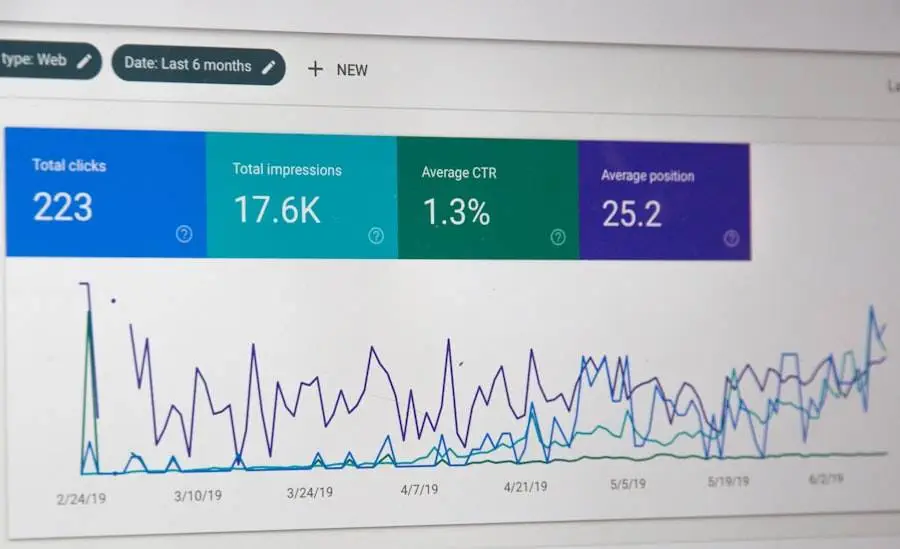Analytics in affiliate marketing is the systematic collection, measurement, and analysis of data to evaluate and enhance the performance of affiliate campaigns. This process involves gathering information on various aspects, including website traffic, conversion rates, and customer behavior. By leveraging analytics, affiliate marketers can obtain valuable insights into the effectiveness of their marketing strategies and make informed decisions based on data to improve their outcomes. That’s equally true for members of Master Affiliate Profits.
A crucial component of understanding analytics in affiliate marketing is the ability to monitor and assess key performance indicators (KPIs). These KPIs encompass metrics such as click-through rates, conversion rates, average order value, and return on investment (ROI). Tracking these KPIs enables affiliate marketers to gain a comprehensive understanding of their campaign performance and identify areas that require improvement.
Analytics also provides essential information about customer demographics, behavior patterns, and preferences. This knowledge allows affiliate marketers to tailor their campaigns to better align with their target audience’s needs and interests. By understanding how customers interact with marketing efforts, marketers can refine their strategies for improved effectiveness.
In summary, a thorough understanding of analytics in affiliate marketing is crucial for optimizing campaign performance and maximizing profitability. It enables marketers to make data-driven decisions, refine their strategies, and better serve their target audience.
Key Takeaways Using Analytics
- Analytics in affiliate marketing provide valuable insights into performance and audience behavior it works for Master Affiliate Profits.
- The best affiliate marketing platform should offer robust analytics and optimization tools
- Analytics can help identify profitable niches and target audience segments for better conversion rates
- Tracking and analyzing customer behavior can lead to increased conversions and higher ROI
- A/B testing and optimization strategies are essential for improving affiliate campaign performance
- Utilizing data to optimize ad spend and ROI can lead to more efficient and effective marketing efforts
- Leveraging analytics is crucial for scaling and growing affiliate profits in a sustainable manner
Choosing the Best Affiliate Marketing Platform for Optimization
When selecting the ideal affiliate marketing platform for optimization, several key factors come into play.
Analytics and Reporting Capabilities
A top-notch affiliate marketing platform should provide detailed analytics and reporting, enabling marketers to track campaign performance and make informed decisions. Robust tracking and reporting capabilities are essential for measuring campaign success and identifying areas for improvement. Master Affiliate Profits has all the analytics that you need.
Support and Resources for Optimization
Another crucial consideration is the level of support and resources the platform offers for optimization. The best platforms provide tools and resources to help marketers refine their campaigns, such as A/B testing, conversion tracking, and audience segmentation. Additionally, access to a knowledgeable support team is vital for receiving guidance and assistance with campaign optimization.
User Interface and Ease of Use
The platform’s user interface and ease of use are also critical factors to consider. A user-friendly platform with intuitive navigation and easy access to analytics and optimization tools can significantly enhance a marketer’s ability to manage and optimize their campaigns effectively.
Utilizing Analytics to Identify Profitable Niches for Master Affiliate Profits

Analytics play a crucial role in helping affiliate marketers identify profitable niches to target. By analyzing data on market trends, customer behavior, and competition, marketers can gain valuable insights into which niches are most likely to generate high returns. One way to utilize analytics for niche identification is by conducting thorough market research to understand the demand for products or services within different niches.
By analyzing search volume, keyword trends, and consumer behavior, marketers can identify niches with high potential for profitability. In addition to market research, analytics can also be used to analyze the performance of existing campaigns within different niches. By tracking KPIs such as conversion rates, average order value, and ROI for different niches, marketers can identify which niches are generating the highest returns.
This data-driven approach allows marketers to focus their efforts on niches that are most likely to be profitable and allocate resources accordingly. Furthermore, analytics can provide insights into emerging trends and opportunities within different niches. By monitoring changes in consumer behavior, market dynamics, and competition, marketers can identify new niche opportunities that align with current market trends.
Overall, utilizing analytics to identify profitable niches is essential for maximizing the effectiveness of affiliate marketing efforts.
Tracking and Analyzing Customer Behavior for Increased Conversions
Tracking and analyzing customer behavior is essential for increasing conversions in affiliate marketing. By understanding how customers interact with a website or campaign, marketers can identify opportunities to optimize the user experience and drive more conversions. One way to track customer behavior is through the use of website analytics tools that provide insights into metrics such as page views, bounce rates, and time on site.
By analyzing this data, marketers can gain a better understanding of how customers navigate their website and identify areas for improvement. In addition to website analytics, tracking customer behavior across different marketing channels can provide valuable insights into the customer journey. By using tools such as multi-channel attribution models and conversion tracking, marketers can gain a holistic view of how customers interact with their marketing efforts across various touchpoints.
This data can help identify which channels and tactics are most effective at driving conversions and inform optimization strategies. Furthermore, analyzing customer behavior can also help marketers understand customer preferences and pain points, allowing them to tailor their messaging and offers to better resonate with their target audience. By leveraging data on customer interactions, marketers can create more personalized and targeted campaigns that are more likely to drive conversions.
Overall, tracking and analyzing customer behavior is crucial for increasing conversions in affiliate marketing.
A/B Testing and Optimization Strategies for Affiliate Campaigns
A/B testing and optimization strategies are essential for maximizing the effectiveness of affiliate campaigns. A/B testing involves comparing two versions of a campaign or webpage to determine which performs better in terms of driving conversions. By testing different elements such as headlines, calls-to-action, or images, marketers can identify which variations are most effective at driving conversions and optimize their campaigns accordingly.
One key aspect of A/B testing is the ability to make data-driven decisions based on the results of the tests. By analyzing metrics such as click-through rates, conversion rates, and average order value for each variation, marketers can gain insights into which elements are most impactful in driving conversions. This data-driven approach allows marketers to make informed decisions about which elements to optimize for maximum impact.
In addition to A/B testing, optimization strategies such as audience segmentation and personalized messaging can further improve campaign performance. By segmenting audiences based on demographics, behavior, or preferences, marketers can create more targeted campaigns that are more likely to resonate with their audience. Furthermore, personalized messaging that speaks directly to the needs and interests of customers can help drive higher engagement and conversions.
Overall, A/B testing and optimization strategies are essential for maximizing the effectiveness of affiliate campaigns. By testing different elements and making data-driven decisions about campaign optimization, marketers can improve their results and drive higher conversions.
Utilizing Data to Optimize Ad Spend and ROI

Understanding the Impact of Marketing Channels
One way to optimize ad spend is by using attribution models to understand the impact of different marketing channels on conversions. By analyzing data on customer touchpoints across various channels, marketers can determine which channels have the highest influence on conversions and adjust their ad spend to prioritize those channels.
Optimizing Ad Spend for Long-term Profitability
Furthermore, analyzing data on customer lifetime value (CLV) can help marketers optimize ad spend for long-term profitability. By understanding the value of customers over time, marketers can make more informed decisions about how much they are willing to invest in acquiring new customers.
Improving ROI through Data Analysis
In addition to optimizing ad spend, analyzing data on campaign performance can also provide insights into opportunities for improving ROI. By tracking KPIs such as conversion rates, average order value, and cost per acquisition, marketers can identify areas for improvement and make strategic adjustments to improve campaign profitability.
Leveraging Analytics to Scale and Grow Affiliate Profits
Leveraging analytics is essential for scaling and growing affiliate profits. By analyzing data on campaign performance and customer behavior, marketers can identify opportunities for expansion and make informed decisions about where to allocate resources for growth. One way to leverage analytics for scaling affiliate profits is by identifying high-performing campaigns or niches that have the potential for expansion.
By analyzing data on conversion rates, ROI, and market trends, marketers can identify which campaigns or niches are most profitable and allocate resources towards scaling those efforts. Furthermore, leveraging analytics can also provide insights into opportunities for diversification and expansion into new markets or product categories. By analyzing data on emerging trends, customer preferences, and competition, marketers can identify new opportunities for growth that align with current market dynamics.
This data-driven approach allows marketers to make strategic decisions about where to invest resources for maximum impact. In addition to identifying opportunities for expansion, leveraging analytics can also help marketers optimize their strategies for long-term growth. By analyzing data on customer lifetime value, retention rates, and repeat purchases, marketers can gain insights into how to maximize long-term profitability from their customer base.
This data-driven approach allows marketers to make informed decisions about how to nurture customer relationships and drive sustainable growth. Overall, leveraging analytics is essential for scaling and growing affiliate profits. By analyzing data on campaign performance, customer behavior, and market dynamics, marketers can make informed decisions about where to allocate resources for expansion and optimize their strategies for long-term growth.
If you’re looking to maximize your profits with affiliate marketing, you may want to check out “The Ultimate List of Affiliate Marketing Resources and Tools for Success” from Master Affiliate Profits Reviewed. This comprehensive article provides a wealth of resources and tools to help you succeed in the world of affiliate marketing. Whether you’re just starting out or looking to take your profits to the next level, this article has everything you need to optimize your affiliate marketing strategy. https://masteraffiliateprofitsreviewed.com/2023/12/20/the-ultimate-list-of-affiliate-marketing-resources-and-tools-for-success/






Leave a Reply